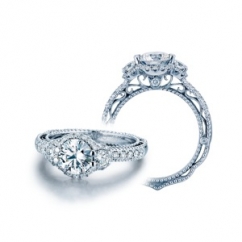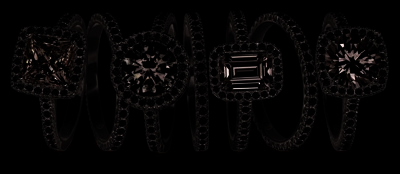Articles and News
MAGIC WORDS WIN BIG BRIDAL SALES | August 17, 2011 (0 comments)

Little Rock, AR—What’s the one thing every prospective groom wants to do when he’s buying an engagement ring?
If you guessed “get a deal,” you’re wrong, says Terry Sisco, a leading motivational speaker and president of Exsellerate!. The one thing a man wants to do, above all else, is make his fiancee happy. Understanding that, and how to use a series of magic words, will almost guarantee not just one ring sale, but three, and possibly also the rest of the bride’s jewelry wardrobe. And that’s no matter what Blue Nile offers, he adds.
Sponsored by Platinum Guild International, Sisco was a featured speaker at the Arkansas Jewelers Association annual convention, held August 13-14 in Little Rock.
With the average engagement ring sale hovering around $7,000 at a prestige-level jewelry store, there’s good motivation to keep the customer focused and comfortable. Meanwhile, the luxury jewelers at the convention observed that Millennial consumers, especially, are all about size.

Bridal jewelry from Coast Diamond, above, and Verragio, top left.
Nothing less than a carat will do. “Don’t even bother showing 98 points,” said Laura Stanley of Stanley Jewelers in Little Rock. Other jewelers in the room concurred, agreeing that "two carats is the new one carat." BJ Burke, also of Stanley Jewelers, pointed out another potential sale: if the daughter is getting a big ring, it frequently sparks a competitive streak in her mother, who now wants an upgrade of her own ring. “We’ve seen that quite a few times,” she said.
“The old selling strategy of ‘greet, probe, uncover objections, show benefits, close,’ doesn’t work with today’s Millennial consumers,” said Sisco. It’s not that you don’t want to close the sale, but these customers do not want to be “sold” in the traditional sense.
What does work for this customer is connecting with them. Making eye contact and smiling are the first steps, of course, but next, use the “Six Degrees of Separation,” he said. There is bound to be something—a person, a place, an interest—the sales associate has in common with the customer. Once that’s established, the rest of the process goes much easier.
Sisco said the best way to get there without old-fashioned “probing” is simply to ask the couple the story of how they met. There will come a point in the retelling where the woman gives a bit of a giggle, and that’s the jeweler’s cue that she’s reached her “happy place,” and will be receptive to the rest of the transaction.
Get her in her happy place first, he said, showing some consumer focus group videos provided by PGI to illustrate the exact moment. “When you get the giggle, you know she’s there,” he said.
Now for the magic words that will almost guarantee the couple will become customers: “A wedding band is an outward and visible symbol of inward and eternal commitment. Is this something you were thinking of sharing with each other?”
At the “yes,” it’s time to start showing product, said Sisco.

A group of rings from Precision Set.
His suggested winning strategy:
“Let’s do this. Let’s find the engagement ring she has been dreaming about and make her happy. Then we’ll find the wedding bands to match it perfectly. But first, let me ask you a question. Has anyone spent time with you to discuss settings and what they’re made of?”
Usually, the answer to that question is going to be “no,” Sisco said, because most traditional sales training emphasizes the diamond. But Millennial consumers are more focused on what the ring looks like as a whole. A fan of sports metaphors, Sisco said this gives the associate the opportunity to run through the hole in the playing field, not just go where all the other players are.
By using this approach, the sales associate zooms in on what the groom wants—to make his bride happy—and in the process begins to plant the idea of buying all three rings at once.
PGI research shows a high percentage of consumers don’t return to the same store to buy their wedding band, and they often treat it as an afterthought. Yet the rings and the photographs are the only trappings of the wedding day that will last forever, said Sisco. Food is eaten, flowers die, the dress is boxed and put up in the attic. Only the rings and photos remain, so why not invest more in the things that last? Most couples get that, he said.
He’s also not a fan of the add-on sale. An add-on sale can leave the customer feeling like they’ve been talked into buying something they don’t really want. Instead, focus on wardrobing. What is the bride going to wear on her wedding day? (Hint: Earrings are an important category here.) Tailor your approach more along the lines of how Amazon.com suggests additional titles when someone’s browsing for a book.
Sisco said PGI focus groups also found that 81% of women surveyed want platinum, but not all are shown platinum in the store. 70% of Blue Nile’s bridal sales are platinum, he said.
A few more statistics from Brides magazine rounded out the presentation:
- 88% of all women get married
- The time between engagement and honeymoon is now 2.5 years
- Seven out of 10 brides research rings before the engagement—as soon as they start talking about it. 71% of brides start looking three months before the actual engagement
- 62% have browsed for rings with their partner
- The metal and the cut of the center stone are primary concerns for the bride.
- 87% of brides specified the metal they want
- 70% of brides want white metal
- Contrary to the observations of the jewelers who told The Centurion size matters, Brides said seven out of 10 brides ranked having a perfect stone more important than the size of the stone.
- Nine out of 10 brides will buy additional jewelry during the engagement leading with earrings.







